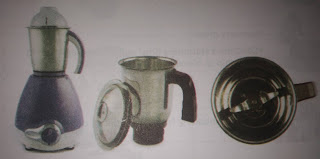To ensure that the mixer/grinder functions properly, it is important to do servicing of components such as speed control switch and gears.
Servicing the speed control switch
A switch is a simple component that is used to stop or start the operation of any motor. A speed control switch is a three speed switch used to select low, medium or high speed by rotating the knob. The speed is controlled by providing varying current to the motor of the mixer/grinder . The following figure lists the steps of servicing a switch :
Servicing the speed control switch
A switch is a simple component that is used to stop or start the operation of any motor. A speed control switch is a three speed switch used to select low, medium or high speed by rotating the knob. The speed is controlled by providing varying current to the motor of the mixer/grinder . The following figure lists the steps of servicing a switch :
Remove the housing around the switch
⬇️
Check the switch terminals
⬇️
Mark the position of terminal wires
⬇️
Disconnect terminal wires
⬇️
Use a continuity tester to test the switch
⬇️
Replace if defective
⬇️
Reconnect the terminal wire
Servicing the Gears
The mixer /grinder has a gear mechanism that rotates the beaters in opposite direction to mix the ingredients.
The following figure lists the steps of servicing the gears :
Unplug the mixer /grinder
⬇️
Remove the housing and expos3 the gears
⬇️
Inspect and lubricate the gears
⬇️
Ensure that the lubricant does not touch motor
⬇️
Remove any pieces or shavings in the housing
⬇️
Reassemble the housing
Replacing a fuse
A fuse is device used to protect the wiring of an electrical appliance from overheating and catching fire due to overload or short circuit. If the motor of the mixer/grinder stops working, its fuse may be blow. The following figure lists the the steps of replacing a fuse:
Remove the housing and access the motor
Disconnect the fuse from the motor
Use a continuity tester to test the fuse
Replac if defective
Reassemble the housing
Replacing the motor
The mixer /grinder /juicer runs on a single -phase induction motor. The following figure lists the steps of replacing the motor:
Remove the housing and access the motor
⬇️
Use a continuity tester to test the motor
⬇️
If defective, remove attached wires
⬇️
Disconnect motor
⬇️
Replace with a motor of same rating
⬇️
Reassemble the housing















